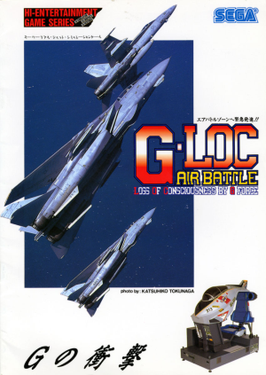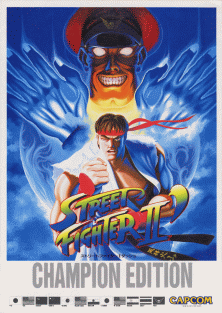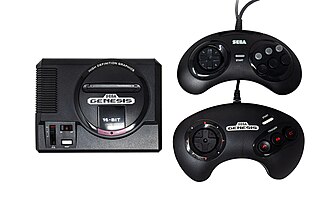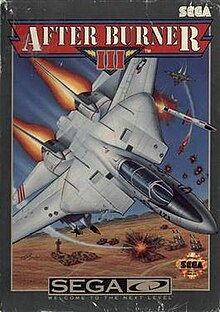
Columns is a match-three puzzle video game released by Jay Geertsen in 1989. Designed for the Motorola 68000-based HP 9000 running HP-UX, it was ported to Mac and MS-DOS before being released commercially by Sega who ported it to arcades and then to several Sega consoles. The game was subsequently ported to other home computers, including the Atari ST.

After Burner is a rail shooter arcade video game developed and released by Sega in 1987. The player controls an American F-14 Tomcat fighter jet and must clear each of the game's eighteen unique stages by destroying incoming enemies. The plane is equipped with a machine gun and a limited supply of heat-seeking missiles. The game uses a third-person perspective, as in Sega's earlier Space Harrier (1985) and Out Run (1986). It runs on the Sega X Board arcade system which is capable of surface and sprite rotation. It is the fourth Sega game to use a hydraulic "taikan" motion simulator arcade cabinet, one that is more elaborate than their earlier "taikan" simulator games. The cabinet simulates an aircraft cockpit, with flight stick controls, a chair with seatbelt, and hydraulic motion technology that moves, tilts, rolls and rotates the cockpit in sync with the on-screen action.

Raiden is a 1990 vertically scrolling shooter arcade video game developed by Seibu Kaihatsu and published by Tecmo in Japan. The game's story takes place in the year 2090, when an alien species known as the Crystals invaded Earth. Players assume the roles of the Vanquish Crystal Defense pilot duo, taking control of two state of the art Fighting Thunders aircraft to defeat the Crystals and save the Earth.

Flicky is a platform game developed by Sega and released as an arcade video game in May 1984. It was licensed to Bally Midway for distribution in the United States. In Flicky, the player controls the eponymous blue bird and must gather all the small birds called Chirps in each round and bring them safely to the exit. There are cat and lizard enemies which can disperse the Chirps and kill the player, but Flicky can use items on the playing field to protect herself and the Chirps from danger.

Silpheed is a video game developed by Game Arts and designed by Takeshi Miyaji. It made its debut on the Japanese PC-8801 in 1986, and was ported to the Fujitsu FM-7 and DOS formats soon after. It was later remade for the Sega CD and has a sequel called Silpheed: The Lost Planet for the PlayStation 2.

Bonanza Bros. is a 3D-style, 2D side-scrolling stealth action game developed and released by Sega in 1990. It is one of the earliest arcade video games powered by the Sega System 24 arcade system board. It was ported to various home systems, including the Mega Drive/Genesis, Master System, PC-Engine/TurboGrafx-CD, and several home computers.

Fatal Fury 2, known as Garō Densetsu 2: Aratanaru Tatakai in Japan, is a 1992 fighting video game developed by SNK as the sequel to Fatal Fury: King of Fighters (1991), and the second game in the Fatal Fury franchise. Originally released by SNK for the Neo Geo arcade and home platforms, it was later ported to several other home systems, including Super Nintendo and Sega Genesis by Takara. Its updated version, Fatal Fury Special, was released in 1993.

G-LOC: Air Battle is a 1990 combat flight simulator arcade video game developed and published by Sega. It is a spin-off of the company's After Burner series. The title refers to "G-force induced Loss Of Consciousness". The game is known for its use of the R360 motion simulator arcade cabinet. The arcade game was a commercial and critical success upon release.

Shinobi is a series of hack-and-slash games created by Sega. The ninja (shinobi) Joe Musashi is the protagonist of the original series of games. The first Shinobi was released in 1987 as an arcade video game. Along with Alex Kidd and Sonic the Hedgehog, Joe Musashi has long been one of Sega's flagship characters, acting as a mascot for a short time in the late 1980s when ninjas were popular in mainstream media. The series' games are a showcase of Sega's technical accomplishment, noted for their high quality of graphics, gameplay and music, as well as their high level of difficulty. The Shinobi franchise sold more than 4.60 million copies.

Thunder Force IV, known in North America as Lightening Force: Quest for the Darkstar, is a shoot 'em up video game developed and published by Technosoft for the Mega Drive in 1992. It is the fourth installment in Technosoft's Thunder Force series, and the third and final one created for the Mega Drive. It was developed by the team at Technosoft that ported Devil's Crush to the Mega Drive rather than the team that developed the previous Thunder Force games. Like its predecessors, it is a horizontally scrolling shooter, but it also features extensive vertical scrolling with large playing fields.

Time Gal is an interactive movie video game developed and published by Taito and Toei Company, and originally released as a laserdisc game in Japan for the arcades in 1985. It is an action game which uses full motion video (FMV) to display the on-screen action. The player must correctly choose the on-screen character's actions to progress the story. The pre-recorded animation for the game was produced by Toei Company.

Super Monaco GP is a Formula One racing simulation video game released by Sega, originally as a Sega X Board arcade game in 1989, followed by ports for multiple video game consoles and home computers in the early 1990s. It is the sequel to the 1979 arcade game Monaco GP. The arcade game consists of one race, the Monaco Grand Prix, but later ports added more courses and game modes based on the 1989 Formula One World Championship.

Valis III is a 1990 action-platform video game originally developed by Laser Soft, published by Telenet Japan and NEC for the TurboGrafx-CD. A Sega Genesis version was released in 1991. It is the third entry in the Valis series. It stars Yuko Asou, a Japanese teenage schoolgirl chosen as the Valis warrior and wielder of the mystical Valis sword after the events of Valis II. King Glames, wielder of the sword Leethus, leads denizens of the dark world to conquer both Vecanti and Earth, seeking refuge for his people amid the destruction of their planet. Together with the demon warrior-maiden Cham and her sister Valna, Yuko must prevent Glames from destroying both worlds. Through the journey, the player explores and searches for items and power-ups while fighting enemies and defeating bosses.

Power Drift is a kart racing game released in arcades by Sega in 1988. More technologically advanced than Sega's earlier 2.5D racing games, like Hang-On (1985) and Out Run (1986), in Power Drift the entire world and track consist of sprites. The upgraded hardware of the Sega Y Board allows individual sprites and the background to be rotated–even while being scaled–making the visuals more dynamic.

Hellfire is a 1989 horizontally scrolling shooter arcade video game originally developed by Toaplan and published in Japan by Taito and North America by U.S.A. Games. The first horizontal shoot 'em up title to be created by Toaplan, the game takes place in the year 2998 where a space matter known as Black Nebula created by robot dictator Super Mech spreads and threatens to engulf human-controlled galaxies, as players assume the role of Space Federation member Captain Lancer taking control of the CNCS1 space fighter craft in a surprise attack to overthrow the enemies with the fighter craft's titular weapon.

Galaxy Force is a rail shooter video game developed and released by Sega for arcades in 1988. The player assumes control of a starship named the TRY-Z, as it must prevent the Fourth Empire from taking over the entire galaxy. Gameplay involves shooting down enemies using either a laser shot or a limited supply of heat-seeking missiles, all while avoiding collision with projectiles or obstacles and making sure the ship's energy meter doesn't fully deplete. It ran on the Sega Y Board arcade system, and was released with a motion simulator cockpit arcade cabinet version like previous Sega Super Scaler games.

Street Fighter is a Japanese media franchise centered on a series of fighting games developed and published by Capcom. The first game in the series was released in 1987, followed by six other main series games, various spin-offs and crossovers, and numerous appearances in other media. Its best-selling 1991 release Street Fighter II established many of the conventions of the one-on-one fighting genre.

Samurai Shodown, known in Japan as Samurai Spirits, is a fighting game developed and published by SNK for the Neo Geo arcade and home platform. Released in 1993, it is the first installment in the Samurai Shodown series. In contrast to other fighting games at the time, which were set in modern times and focused primarily on hand-to-hand combat, Samurai Shodown is set in feudal-era Japan and was SNK's first arcade fighting game to focus primarily on weapon-based combat.

Street Fighter II: Champion Edition, released as Street Fighter II Dash in Japan, is a fighting game released by Capcom in 1992. It was launched for arcades and converted to several video game consoles. It is the first of several updated versions of Street Fighter II, and part of the Street Fighter series. The main changes are the addition of the four grand masters as playable characters and mirror matches. The fighting techniques of the eight main characters from the original game were further balanced for competitive play.

The Sega Genesis Mini, known as the Mega Drive Mini in regions outside of North America, is a dedicated console modeled on the Sega Genesis. The Mini emulates the original console's 16-bit hardware, and includes 42 games made available through emulation software by M2. It was released in North America and Japan in September 2019 and in Europe and the Middle East in October 2019. A follow-up, Sega Genesis Mini 2, was released in October 2022 and includes 60 games from the Genesis and Sega CD.




















